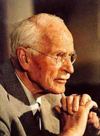Carl Gustav Jung
Carl Jung was a Swiss psychologist who lived from 1875 to 1961. He recognized the richness of unconscious processes, and worked diligently to explore the human psyche. He is known for his discoveries of the persona, the shadow, complexes and archetypes. He also developed methods or entering into a dialogue with the unconscious through dreams, active imagination, and the arts. His work is very relevant for today’s world, which calls out for connection to the unconscious.
C.G. Jung’s work has permeated our culture in so many ways it is impossible to categorize his influence. Did you know:
Gender: Jung helped to untie the relationship between sex (biology) and gender (acculturation). His notions of anima and animus (the unconscious contra-sexual aspects of the psyche) have made way for a more fluid relationship to gender that characterize our post-modern world.
Transpersonal Psychology: Jung’s concept of the collective unconscious convinced the psychological world that there were states of consciousness beyond the personal that could be empirically investigated. Jung even used the word transpersonal in his writing. His concepts verified how humans are cross-culturally interconnected through the unconscious, as expressed in dreams and symbols, and, as a result our personal psychological work can influence the world around us. From the beginning, Jung valued the role of nature and animals in our healing.
Mythology: Jung’s work was steeped in mythology and his interest probably was responsible for its resurgence over the decades. For Jung, mythology was a way to understand the archetypal narratives and patterns that live within each of us, offering deeper insight into both personal and collective issues. Once again, the collective unconscious expresses itself through these stories and confirms the inherent spiritual nature of the unconscious.
Science: Jung viewed himself as a scientist and was fascinated by physics as a way to understand the psyche. His conversations with Einstein and Wolfgang Pauli are examples of how Jung investigated the world around him so as to understand the inner world of the individual. In fields, such as cognitive science, there are parallels drawn between archetypes and the fundamental ordering structures of language and the mind. For instance, the lie detector test is the result of Jung’s research with the Word Association Test that led to his ideas on typology and complex theory. The Myer’s Briggs Personality Test is further a result of Jung’s pivotal research into typology (CW, Volume 6). We now see Jung’s complex theory imbedded in trauma theories, somatic psychology, cognitive behavior approaches, or solution oriented therapy while his conceptualizations on how the psyche (brain) worked are now being more clearly validated by neuroscience, including the healing value of symbolic thinking, imagination and metaphor, the titration of the two sides of the brain, and the influence and relationship between the lower brain stem with the more developed areas of the brain.
Language: Jungian psychology has become part of our everyday speak. For instance, “shadow” or “individuation” are now commonly used to describe what is hidden and our path as individuals becoming conscious, respectively. His investigations into the scientific idea of synchronicity, (meaningful coincidences), is commonly when referring to personal experiences.
The Spiritual movement: Jung’s research into alchemy, eastern religion, and his openness to psychic phenomena, mythology and women’s and men’s individuation and spirituality have all helped to make alternative spiritual interests part of mainstream culture. His courage to view the collective from an alternative lens, (a journey documented in The Red Book) changed how we view ourselves and relate to the world.
Transference/Countertransference: Often overlooked by the psychological community, Jung was influential in the explorations of the complexity inherent within therapeutic relationships (transference/counter-transference). What psychologists refer to as inter-subjective field or “field theory” reflect his investigations that emerged from his interest in alchemy and was eventually more specifically laid out in his work: “Psychology of the Transference”.


